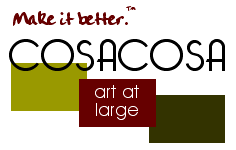



"An identity would seem to be arrived at by the way in which the person faces and uses his experience"
- James Baldwin
In confronting our experience of the world we uncover our identities, and, ultimately, our individuality. We blossom into our true selves. But to know and understand our experiences and place in this world is often a complex matter. Most people struggle on a regular basis with both the concept and practicalities of such knowledge. How do we discover our identity? While a definitive method remains undefined, we tend to invoke our individual, cultural, and community experiences as guides.
Working as a teaching artist with COSACOSA, I asked a group of teens about their thoughts on identity as we designed a new mosaic for their school. The majority of them were perplexed until presented with examples. Afterward, these same students immediately identified themselves by nationality or ethnicity: “I’m black;” “I’m Latino;” “I’m Liberian,” and so on. Labels are appealing, no matter who we are, what culture we’re from, or which community we represent. At one time or another, we all resort to classifying our identity: “I’m a teacher;” “I’m Jewish;” “I’m American.” And the labels we use communicate our worldview and values to others.
Although we seek to define our individuality and those characteristics that make us unique, inherent in all of us is a yearning to belong, a desire to identify with others who share our interests and beliefs. We like the safety of belonging to a group, and ironically, our very identification with particular community also helps to shape our identity. We need to “represent” the set to which we belong, e.g., the African American community, the gay community, or even the global community. The fact that most people do not associate with just one community truly complicates the matter. And we’re often “assigned” various community identities based on others’ assumptions or sterotypes, common interests and proximities, or just by the societal status quo.
In truth, our individual identities are compiled of a myriad of little things, making each of us unlike any other person. Like a mosaic, individuals are made up of a many pieces joining together artfully to form something beautiful and unique. As my students pointed out in our later discussions, within each of us are a multitude of personalities and behaviors we reveal at different times. For example, a person can go from being sweet and angelic one moment to mean and devilish the next. Or how do you explain actors who are outgoing on the stage but introverted in real life?
Yet despite our persistent quest for our own singularity, we all are connected and indivisible; each of our individual mosaics is part of a bigger picuture. Every individual identity is like a single stem in a garden replete with life of all sizes, shapes, and colors. The more we learn about and cultivate ourselves, the more we’ll grow and blossom into the true flower of our existence. And the more vibrant our flower, the more beautiful the garden, as a whole, will be.
Sharnae Mask is a new media artist specializing in youth development projects using photography and film. She previously served as COSACOSA's Program Manager and, as a teen, was a member of our Youth Council.
Artolatry bread image after Salvadore Dalí's Basket of Bread (1926).